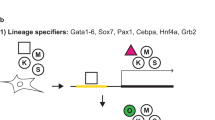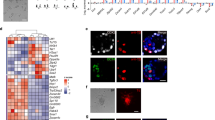Abstract
Since the initial description of induced pluripotent stem (iPS) cells created by forced expression of four transcription factors in mouse fibroblasts, the technique has been used to generate embryonic stem (ES)-cell-like pluripotent cells from a variety of cell types in other species, including primates and rat1,2,3,4,5,6. It has become a popular means to reprogram somatic genomes into an embryonic-like pluripotent state, and a preferred alternative to somatic-cell nuclear transfer and somatic-cell fusion with ES cells7,8. However, iPS cell reprogramming remains slow and inefficient. Notably, no live animals have been produced by the most stringent tetraploid complementation assay, indicative of a failure to create fully pluripotent cells. Here we report the generation of several iPS cell lines that are capable of generating viable, fertile live-born progeny by tetraploid complementation. These iPS cells maintain a pluripotent potential that is very close to ES cells generated from in vivo or nuclear transfer embryos. We demonstrate the practicality of using iPS cells as useful tools for the characterization of cellular reprogramming and developmental potency, and confirm that iPS cells can attain true pluripotency that is similar to that of ES cells.
This is a preview of subscription content, access via your institution
Access options
Subscribe to this journal
Receive 51 print issues and online access
$199.00 per year
only $3.90 per issue
Buy this article
- Purchase on Springer Link
- Instant access to full article PDF
Prices may be subject to local taxes which are calculated during checkout



Similar content being viewed by others
Accession codes
Primary accessions
Gene Expression Omnibus
Data deposits
The microarray data in this study have been deposited with the Gene Expression Omnibus repository (http://www.ncbi.nlm.nih.gov/geo) under accession number GSE16925.
References
Takahashi, K. & Yamanaka, S. Induction of pluripotent stem cells from mouse embryonic and adult fibroblast cultures by defined factors. Cell 126, 663–676 (2006)
Takahashi, K. et al. Induction of pluripotent stem cells from adult human fibroblasts by defined factors. Cell 131, 861–872 (2007)
Liu, H. et al. Generation of induced pluripotent stem cells from adult rhesus monkey fibroblasts. Cell Stem Cell 3, 587–590 (2008)
Li, W. et al. Generation of rat and human induced pluripotent stem cells by combining genetic reprogramming and chemical inhibitors. Cell Stem Cell 4, 16–19 (2009)
Liao, J. et al. Generation of induced pluripotent stem cell lines from adult rat cells. Cell Stem Cell 4, 11–15 (2009)
Yu, J. et al. Induced pluripotent stem cell lines derived from human somatic cells. Science 318, 1917–1920 (2007)
Munsie, M. J. et al. Isolation of pluripotent embryonic stem cells from reprogrammed adult mouse somatic cell nuclei. Curr. Biol. 10, 989–992 (2000)
Tada, M., Takahama, Y., Abe, K., Nakatsuji, N. & Tada, T. Nuclear reprogramming of somatic cells by in vitro hybridization with ES cells. Curr. Biol. 11, 1553–1558 (2001)
Wernig, M. et al. In vitro reprogramming of fibroblasts into a pluripotent ES-cell-like state. Nature 448, 318–324 (2007)
Maherali, N. et al. Directly reprogrammed fibroblasts show global epigenetic remodeling and widespread tissue contribution. Cell Stem Cell 1, 55–70 (2007)
Okita, K., Nakagawa, M., Hyenjong, H., Ichisaka, T. & Yamanaka, S. Generation of mouse induced pluripotent stem cells without viral vectors. Science 322, 949–953 (2008)
Aoi, T. et al. Generation of pluripotent stem cells from adult mouse liver and stomach cells. Science 321, 699–702 (2008)
Kim, J. B. et al. Pluripotent stem cells induced from adult neural stem cells by reprogramming with two factors. Nature 454, 646–650 (2008)
Eminli, S., Utikal, J., Arnold, K., Jaenisch, R. & Hochedlinger, K. Reprogramming of neural progenitor cells into induced pluripotent stem cells in the absence of exogenous Sox2 expression. Stem Cells 26, 2467–2474 (2008)
Hanna, J. et al. Treatment of sickle cell anemia mouse model with iPS cells generated from autologous skin. Science 318, 1920–1923 (2007)
Wernig, M. et al. Neurons derived from reprogrammed fibroblasts functionally integrate into the fetal brain and improve symptoms of rats with Parkinson's disease. Proc. Natl Acad. Sci. USA 105, 5856–5861 (2008)
Shi, Y. et al. Induction of pluripotent stem cells from mouse embryonic fibroblasts by Oct4 and Klf4 with small-molecule compounds. Cell Stem Cell 3, 568–574 (2008)
Huangfu, D. et al. Induction of pluripotent stem cells by defined factors is greatly improved by small-molecule compounds. Nature Biotechnol. 26, 795–797 (2008)
Stadtfeld, M., Nagaya, M., Utikal, J., Weir, G. & Hochedlinger, K. Induced pluripotent stem cells generated without viral integration. Science 322, 945–949 (2008)
Kaji, K. et al. Virus-free induction of pluripotency and subsequent excision of reprogramming factors. Nature 458, 771–775 (2009)
Woltjen, K. et al. piggyBac transposition reprograms fibroblasts to induced pluripotent stem cells. Nature 458, 766–770 (2009)
Nagy, A. et al. Embryonic stem cells alone are able to support fetal development in the mouse. Development 110, 815–821 (1990)
Jaenisch, R. & Young, R. Stem cells, the molecular circuitry of pluripotency and nuclear reprogramming. Cell 132, 567–582 (2008)
Meissner, A., Wernig, M. & Jaenisch, R. Direct reprogramming of genetically unmodified fibroblasts into pluripotent stem cells. Nature Biotechnol. 25, 1177–1181 (2007)
Takahashi, K., Okita, K., Nakagawa, M. & Yamanaka, S. Induction of pluripotent stem cells from fibroblast cultures. Nature Protocols 2, 3081–3089 (2007)
Cheng, J., Dutra, A., Takesono, A., Garrett-Beal, L. & Schwartzberg, P. L. Improved generation of C57BL/6J mouse embryonic stem cells in a defined serum-free media. Genesis 39, 100–104 (2004)
Blelloch, R., Venere, M., Yen, J. & Ramalho-Santos, M. Generation of induced pluripotent stem cells in the absence of drug selection. Cell Stem Cell 1, 245–247 (2007)
Zeng, F. & Schultz, R. M. RNA transcript profiling during zygotic gene activation in the preimplantation mouse embryo. Dev. Biol. 283, 40–57 (2005)
Nagy, T., Vintersten, K. & Behringer, R. Manipulating the Mouse Embryo: A Laboratory Manual 3rd edn (Cold Spring Harbor Laboratory Press, 2003)
Yoshimizu, T. et al. Germline-specific expression of the Oct-4/green fluorescent protein (GFP) transgene in mice. Dev. Growth Differ. 41, 675–684 (1999)
Chatot C. L, Ziomek, C. A., Bavister, B. D., Lewis, J. L. & Torres, I. An improved culture medium supports development of random-bred 1-cell mouse embryos in vitro. J. Reprod. Fertil. 86, 679–888 (1989)
Zhou, Q., Jouneau, A., Brochard, V., Adenot, P. & Renard, J. P. Developmental potential of mouse embryos reconstructed from metaphase embryonic stem cell nuclei. Biol. Reprod. 65, 412–419 (2001)
Love, J. M., Knight, A. M., McAleer, M. A. & Todd, J. A. Towards construction of a high resolution map of the mouse genome using PCR-analysed microsatellites. Nucleic Acids Res. 18, 4123–4130 (1990)
Olivares, E. C. et al. Site-specific genomic integration produces therapeutic Factor IX levels in mice. Nature Biotechnol. 20, 1124–1128 (2002)
Zeng, F., Baldwin, D. A. & Schultz, R. M. Transcript profiling during preimplantation mouse development. Dev. Biol. 272, 483–496 (2004)
Acknowledgements
This study was supported in part by grants from the China National Basic Research Program 2006CB701500 (to Q.Z.), 2007CB947800 (to F.Z.), 2007CB947700 (to L.W.) and grants from the National Science Foundation of China 30525040 (to Q.Z.) and 30871379/C0607 (to F.Z.).
Author Contributions Q.Z. and F.Z. designed the experiments, supervised lab work, analysed and interpreted data, and wrote the paper; X.Z., W.L., Z.L., L.L., M.T., T.H., J.H., C.G., Q.M. and F.Z. performed experiments; L.L. and W.L. analysed data; W.L. supervised experiments; and X.Z., W.L. and Z.L. contributed to part of the Online Methods section.
Author information
Authors and Affiliations
Corresponding authors
Supplementary information
Supplementary Information
This file contains Supplementary Figures S1-S6 with Legends and Supplementary Tables S1-S3. (PDF 4219 kb)
Rights and permissions
About this article
Cite this article
Zhao, Xy., Li, W., Lv, Z. et al. iPS cells produce viable mice through tetraploid complementation. Nature 461, 86–90 (2009). https://doi.org/10.1038/nature08267
Received:
Accepted:
Published:
Issue Date:
DOI: https://doi.org/10.1038/nature08267
This article is cited by
-
Integration-free induced pluripotent stem cells from three endangered Southeast Asian non-human primate species
Scientific Reports (2024)
-
A fast chemical reprogramming system promotes cell identity transition through a diapause-like state
Nature Cell Biology (2023)
-
Applications of synthetic biology in medical and pharmaceutical fields
Signal Transduction and Targeted Therapy (2023)
-
Transcriptomic landscape reveals germline potential of porcine skin-derived multipotent dermal fibroblast progenitors
Cellular and Molecular Life Sciences (2023)
-
Rethinking nomenclature for interspecies cell fusions
Nature Reviews Genetics (2022)
Comments
By submitting a comment you agree to abide by our Terms and Community Guidelines. If you find something abusive or that does not comply with our terms or guidelines please flag it as inappropriate.



